Nijmegen, Kops Plateau
Q3921197Nijmegen: city in the Netherlands, where several Roman settlements have been discovered.
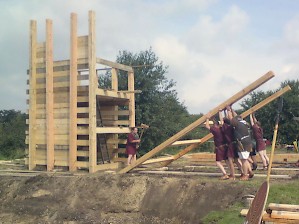
The Kops Plateau in eastern Nijmegen, was the site of a Roman fort that was founded during Drusus' campaigns across the Rhine (12-9 BCE), and was destroyed during the Batavian Revolt (70 CE). It was close to the great legionary base at the Hunerberg. Both military settlements were build on an ice-pushed ridge, a safe and dry location near the river Waal, the main distribuary branch of the Rhine.
First phase (c.12 BCE - c.10 CE)
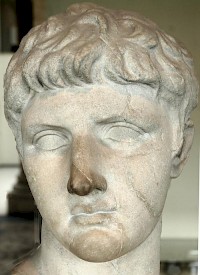
The fort was founded when the Roman prince Drusus tried to conquer the valleys of the Main and Lippe, east of the Rhine. The Greek-Roman author Cassius Dio seems to imply that the Batavian territories had already been pacified before the first campaign started in 12 BCE, because Drusus could pass by the Batavians.note However, the same line suggests that Nijmegen was the node of that year's dual operation: first, an attack on the Usipetes and Sugambri, followed by a return to the starting point and an expedition to the Frisians. That Nijmegen was the place where the two operations were coordinated, is not illogical.
The praetorium, the mansion of the commander of the fort at the Kops Plateau, was splendid. It measured about 2000 square meter (60x35 meter) and looked like the villas of Italy. Archaeologists were able to establish that the rooms west of the little court were used for official meetings, while the eastern rooms served as the commander's private rooms. The immense luxury can best be illustrated by the garbage dump that appeared to contain the remains of one single diner: except for a large cauldron, a lot of pots and - oddly some coins, the bones of about two hundred fishes (carp, eel, pike, tench, bream, perch, mackerel from Spain), duck, beef, hare, sucking pig, chicken, barley, lentils, and olives. This was a meal fit for a prince, even though we do not know whether he was Drusus, Tiberius, or a more distant member of the imperial family like Varus.
The fort was surrounded by a double ditch. Traces of the pebble pavement of the two main roads have been found, the principia (the HQs of the fort itself) and a granary have been identified, but there appear to have been no barracks within the walls. The stables were to the south of the fort, outside the walls. here must have stood the horse of Titus Ussus, the eques mentioned on a badly legible sherd that suggests that legionaries of I Germanica in this time belonged to the garrison of Nijmegen.
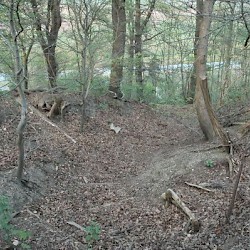 Nijmegen, Kops Plateau, Northern slope |
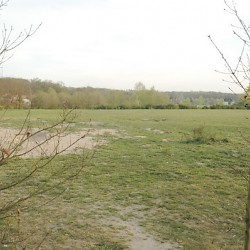 Nijmegen, Kops Plateau, seen from the northwest |
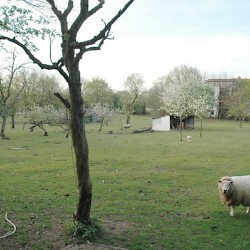 Nijmegen, Kops Plateau, Site of the cemetery |
Second phase (c.10-c.40)
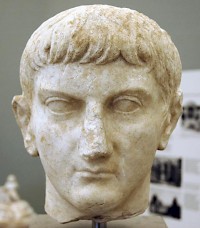
After the Roman defeat in the battle in the Teutoburg Forest (September 9 CE), the legions and auxiliary units were redeployed. Drusus' son Germanicus was responsible for several retaliatory attacks and must have been in Nijmegen, where several temporary bases have been identified that must have offered accomodation to the large armies that invaded Germany in 14-16.
The Kops Plateau fort started to have a function as a normal fort: it was expanded to the south to accomodate more people. Although it now measured about 300 x 250 meter, it covered about five hectare, becausee it was not a normal, square fort. The walls were rebuilt, except for the northern side, which was left open; given the fact that it was almost impossible to climb to the fort, this was less dangerous than it seems. After Germanicus' operations, the Hunerberg fortress was evacuated, leaving the Kops Plateau as the main military settlement near Nijmegen.
Third phase (c.40-69)
The fort was redesigned in c.40. Again, this had something to do with the redeployment of Roman troops. The emperor Caligula (a son of Germanicus) waged war against the Chatti and appears to have had plans to cross over to Britain; in these years, he visited Germania Inferior and appears to have initiated the defensive strategy that is commonly known as the limes - the construction of permanent forts and watchtowers dates back to the early forties. At this time, the Kops Plateau became the home of a cavalry unit, probably the Ala I Batavorum.
The southern border of the fort was moved a bit to the north, inside the old double ditch of the first building phase. The cemetery of the fort was discovered a bit to the south of the Kops Plateau, at the Kruisweg. All graves can be dated after 50, and it is remarkable that no urns were found. The bodies were cremated completely, and buried with the wood. Because the citizens of Batavodurum used urns to bury their dead, the conclusion seems inevitable that soldiers received a different type of cremation.
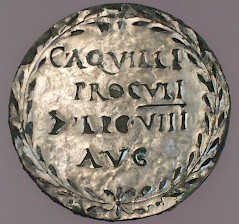
The end of the fort at the Kops Plateau was abrupt. In 69, a Batavian leader named Julius Civilis revolted. The Roman officer Aquilius was able to organize the withdrawal of the Roman troops from the Rhineland (a silver medal with his name was found at the Kops Plateau), and an army was sent to the northwest to suppress the rebellion. However, when the battle started, the Batavian cavalry in the Roman army, led by one Claudius Labeo, switched sides and started to support the rebels.note It cannot be proved that Labeo was the commander of the unit at the Kops Plateau, but it is plausible, and the defection of the unit explains why its fort was not destroyed - the only fort in Germania Inferior without burning layer. Later, the unit was defeated by the Romans, and when the legions restored order in the Nijmegen area, they found the fort empty.
Fourth phase (after 70)
The fort was never used again, but to the east of it, a cemetery has been found. No graves were discovered within the walls of the former fort, though, suggesting that it was still recognizable as a military site.
The Kops Plateau was identified as a major archaeological site in 1914, and the first excavations lasted until 1921. It was believed to be the Oppidum Batavorum mentioned by Tacitus; in the seventies, however, it was shown that this settlement was in the center of modern Nijmegen. After excavations in 1986-1995, archaeologists understood that the Kops Plateau was a fort of an unusual type.
During the 1991 excavations, two cavalry helmets were excavated; both can be dated to the middle of the first century; a third helmet had already been found (at an unknown site) in the nineteenth century. They are of different types. On the helmet on the second photo below, the part that protects the face is attached to the helmet itself by a bolt; the third one has two hinges, while the first one has one hinge. All helmets have traces of silver.
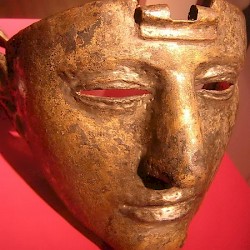 Nijmegen, Kops Plateau, Cavalry mask |
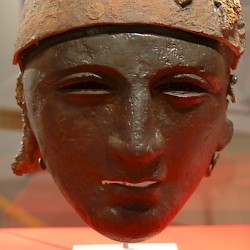 Nijmegen, Kops Plateau, Helmet |
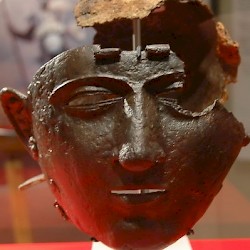 Nijmegen, Kops Plateau, Helmet |
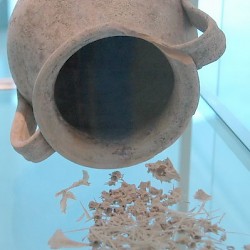 Nijmegen, Kops Plateau, Imported mackerel |